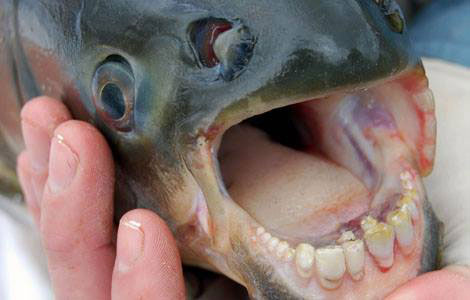When animals were evolving on this planet, a few of them got the short end of the stick when it comes to looks. But they often make up for it in abilities. Here are some weird and wonderful animals roaming our planet that you may not have heard about.

Mantis shrimp
The mantis shrimp is an incredible-looking creature found in the warm waters of the Pacific and Indian Oceans. This shrimp is likely one of the most colourful animals out there, with bright greens, oranges, reds, yellows and blues.
One of the most interesting things about these crustaceans is its eyes: they contain millions of light-sensitive cells with upwards of 12 to 16 colour-receptive cones, compared to our measly three. Scientists believe that this allows them to detect ten times more colour than humans. And their eyes are also pretty amazing for another reason: they can move around independent of one another.
WATCH: Discover the mantis shrimp
But wait: there’s more. This shrimp packs quite a punch. It has two front legs with club-like ends that it folds under its body, much like a preying mantis. But when fending off an intruder into its homes, it lashes out at them powerfully. The punch is so fast that it’s unseen to the human eye. When scientists at the University of California, Berkeley, tried to study their punches on video, they found their high-speed equipment just wasn’t fast enough. Eventually they were able to get hold of a special camera and they discovered that the tiny legs lash out at 80 km/h, making it one of the fastest movements of any animal.
Coconut crab
See the image below? That’s a crab. A really big crab.
No, this isn’t some crab that’s been irradiated after Fukushima, but rather the coconut crab (Birgus latro), the largest arthropod on Earth. Spiders, crustaceans and insects belong to this group that live on land (the Japanese spider crab is bigger than the coconut crab, but it lives underwater).

Get daily National news
READ MORE: What is this bizarre creature?
This crab lives on islands throughout the Indian and Pacific Oceans. They eat fleshy fruit as well as other crabs, as well as kittens and chickens. Of course, they eat coconut, a reason for their nickname (they’re also known as the robber crab as they are known to steal things like pots and other household items). They manage this task by peeling off the husk with those enormous pincers and then hitting it over and over again until it breaks open.
Not a lot is known about the population of these amazing creatures, so it is unknown if they are endangered or not.
Penis snake
It looks exactly like its name.
Of course, that’s not its official name. Instead, this strange-looking snake that’s between an earthworm and a snake is called Atretochoana eiselti.
The IUCN reports that there have only ever been two specimens ever found: one in 1800 in an unspecified location in South America and the second, in 2011 in Brazil where six were found in the Madeira River.
And this snake isn’t really a snake but a type of caecilian, a limbless amphibian and, though aquatic, breathes through its skin.
As for its, ahem, size, one was found measuring 32 inches.
Pacu
It’s been called the “testicle-eating fish.” But don’t worry: it seems to be a myth. Still, you wouldn’t want to get bitten by a pacu.
When you first see a pacu, you might think that it’s just an ordinary fish. But when you open up its mouth, you realize it’s nothing of the sort.
Found in South America, pacu have a mouth full of human-looking teeth.
In June 2015, a pacu was caught by a fisherman in Swedes Lake, New Jersey. It’s believed that someone dumped a pet into the lake.
Pacu are a relative of the piranha. The good news is they don’t eat anything resembling, um, nuts. Instead, they feed mainly on plants, but occasionally eat other fish.

A pacu fish
Tufted deer
It’s like a vampire mated with a cute, fuzzy deer.
Meet the tufted deer, an animal named for the long, dark hair growing on its forehead.

This cute animal is found in central and southern China. Though there are old reports of them being found in Myanmar, recent surveys have failed to find any.
The mostly grey deer (with a white tail) is, like most deer: shy and elusive, mostly coming out at dusk or dawn. They live in damp forests high in China, preferring to eat grass fruits, bamboo and herbs.
Sadly, the IUCN Red List, which tracks threatened species around the world, has listed this deer as near-threatened, with the main threat being humans. In the 1970s and 1980s more than 100,000 tufted deer were hunted and killed.








Comments